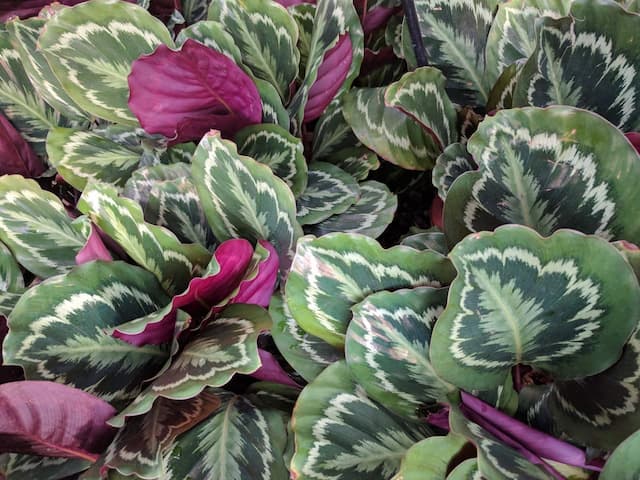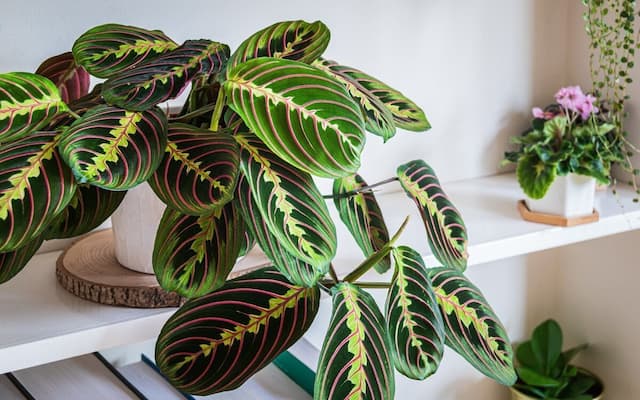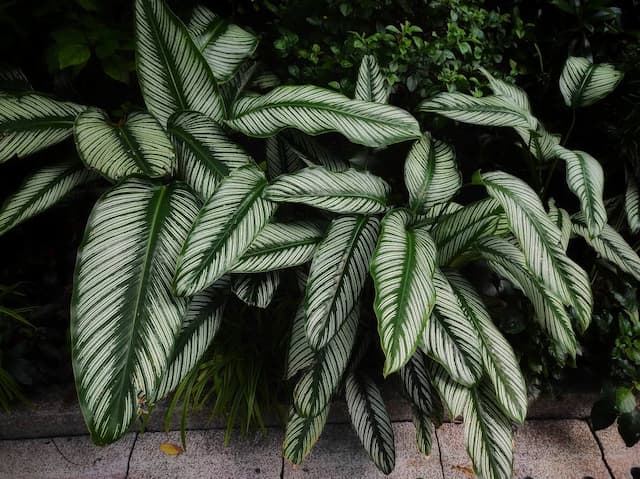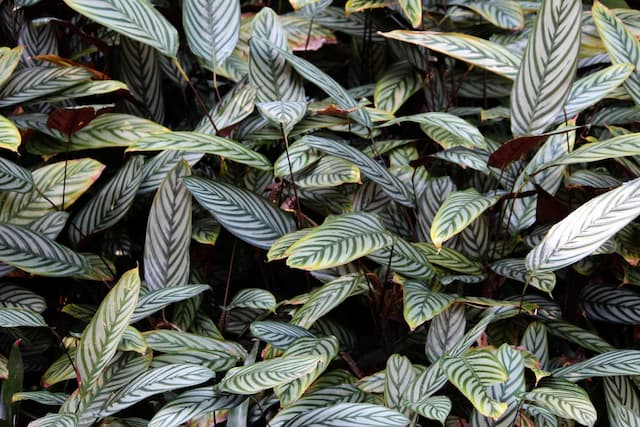Triostar Stromanthe Stromanthe sanguinea var. spectabilis

ABOUT
Commonly known as the tricolor stromanthe, this plant is admired for its striking and colorful foliage. The leaves are a true spectacle with their multi-hued palette. On the top, you'll find shades of green contrasted with cream and light pink stripes running along the elongated leaf blades. The undersides are equally captivating with a rich, magenta or purplish-red, making the plant stand out when the leaves are turned by the wind or when they move to follow light sources. The leaves themselves are glossy and have a slightly wavy edge, contributing to the plant's lush, tropical look. The arrangement of the leaves is typically in a clump, where they fan out from the central base of the plant, creating an attractive, dense cluster. When in bloom, which is less common indoors, the tricolor stromanthe produces small, non-showy flowers. The beautiful variegation and striking leaf colors make the tricolor stromanthe a favorite among houseplant enthusiasts, bringing an exotic and vibrant splash of color to any indoor space. This plant, with its painterly leaves, serves not just as greenery but as a living piece of art.
About this plant
 Names
NamesFamily
Marantaceae
Synonyms
Triostar Stromanthe, Tricolor Stromanthe, Magenta Triostar
Common names
Stromanthe jacquinii, Stromanthe thalia, Phrynium jacquinii, Maranta sanguinea, Maranta spectabilis, Phrynium spectabile.
 Toxicity
ToxicityTo humans
The most common name for Stromanthe sanguinea var. spectabilis is Triostar Stromanthe. This plant is generally considered non-toxic to humans. However, as with any plant material, ingestion might cause mild stomach upset in some individuals due to the fiber content or plant compounds. No significant symptoms of poisoning are expected from ingesting this plant.
To pets
The Triostar Stromanthe is also non-toxic to pets. This includes cats and dogs, two common household pets that might come into contact with the plant. There are no specific symptoms of poisoning associated with the ingestion of this plant, and it is not known to cause any severe or life-threatening toxicity. However, like any non-food item, ingestion of large amounts of plant material could potentially lead to gastrointestinal disturbance such as vomiting or diarrhea simply due to ingestion of non-digestible matter.
 Characteristics
CharacteristicsLife cycle
Perennials
Foliage type
Evergreen
Color of leaves
Variegated
Height
2 feet [60 cm]
Spread
2 feet [60 cm]
Plant type
Herb
Hardiness zones
10
Native area
Brazil
Benefits
 General Benefits
General Benefits- Aesthetic Appeal: Stromanthe sanguinea, commonly known as Tricolor Stromanthe, is known for its striking foliage with vibrant colors and patterns, which can enhance the visual appeal of any indoor or outdoor space.
- Easy to Grow: Tricolor Stromanthe is relatively easy to care for, making it suitable for gardeners of all skill levels.
- Humidity Tolerance: It thrives in humid conditions, making it an ideal plant for bathrooms or kitchens where humidity levels are typically higher.
- Shade Tolerance: Tricolor Stromanthe can grow in low-light conditions, which makes it an excellent choice for spaces with limited natural light.
- Non-toxicity: This plant is non-toxic to cats and dogs, which is an important consideration for pet owners when choosing houseplants.
- Compact Size: Being a relatively compact plant, it fits well in smaller spaces or as part of a terrarium or tabletop arrangement.
 Medical Properties
Medical PropertiesThis plant is not used for medical purposes.
 Air-purifying Qualities
Air-purifying QualitiesThis plant is not specifically known for air purifying qualities.
 Other Uses
Other Uses- Packaging Material: Stromanthe leaves can be repurposed as a biodegradable alternative for wrapping small items, providing a sustainable packaging option.
- Artistic Medium: Artists may use the broad, colorful leaves of the Triostar Stromanthe for creating eco-friendly art pieces or as canvases for natural paint.
- Dye Source: The vibrant pigments in Triostar Stromanthe leaves could be used to create natural dyes for textiles or crafts.
- Photography Backdrops: The striking foliage can serve as a lush backdrop or accent in portrait and macro photography.
- Teaching Aid: Botany educators might employ the plant to help students learn about variegated leaf patterns and plant physiology.
- Table Centerpieces: Arrangements of Triostar Stromanthe can be utilized as living table centerpieces for eco-conscious events.
- Horticultural Therapy: The care required for this plant can provide therapeutic benefits to individuals recuperating from illness or stress.
- Fashion Inspiration: The distinctive leaves can inspire patterns and color schemes in the fashion industry, from fabric designs to accessories.
- Event Decor: The plant can be used to add a tropical flair to event spaces, like weddings or parties, without extensive floral arrangements.
- Bioindicators: Triostar Stromanthe may serve as bioindicators to monitor the health of indoor environments, showing sensitivity to chemicals or poor water quality.
Interesting Facts
 Feng Shui
Feng ShuiThe plant Stromanthe Triostar is not used in Feng Shui practice.
 Zodiac Sign Compitability
Zodiac Sign CompitabilityThe Stromanthe Triostar is not used in astrology practice.
 Plant Symbolism
Plant Symbolism- Creativity: The vibrant and variegated leaves of the Triostar Stromanthe often symbolize creativity and artistic expression, reflecting its own unique and striking pattern.
- Diversity: Triostar Stromanthe's diverse coloration, ranging from green to pink to white, can symbolize the beauty of diversity and the acceptance of different characteristics and traits.
- Balance: The balanced growth of the Triostar Stromanthe, along with its need for the right amount of light and water, may symbolize the importance of balance in life, reminding us to strive for equilibrium.
- Radiance: With its glossy and radiant leaves, the Triostar Stromanthe represents inner radiance and the idea that beauty comes from within, shining outwardly.
 Water
WaterThe Triostar Stromanthe should be watered when the top inch of soil feels dry to the touch, typically once a week, but this can vary based on environmental conditions such as temperature and humidity. Use lukewarm water and pour it evenly over the soil until it begins to drain from the bottom of the pot; this could be roughly between 16 to 32 ounces for a medium-sized pot, every watering session. It is crucial not to let the plant sit in water as it can lead to root rot. During the winter months, reduce the frequency of watering as the plant's growth slows down. Always check the soil moisture level before watering to avoid overwatering.
 Light
LightTriostar Stromanthe thrives in bright, indirect light but can tolerate moderate shade. Avoid exposing it to direct sunlight, as this can scorch the leaves and fade the vibrant colors. A north or east-facing window is a good spot, providing the dappled light that mimics the plant's natural under-canopy habitat. If you notice the plant's leaves losing their variegation, this may be a sign that the plant needs more light.
 Temperature
TemperatureTriostar Stromanthe prefers temperatures between 65 and 80 degrees Fahrenheit during the day and should not be exposed to temperatures below 50 degrees Fahrenheit, as cold drafts can damage the plant. Maintain a consistent indoor temperature and protect the plant from sudden temperature drops, such as those near air conditioning vents or drafty windows, to ensure its health and vitality.
 Pruning
PruningTriostar Stromanthe benefits from occasional pruning to remove any yellow or damaged leaves, which helps to encourage healthy new growth and maintain an attractive appearance. Prune sparingly, as needed, rather than on a strict schedule. The best time to prune is during the growing season, which is spring and summer.
 Cleaning
CleaningAs needed
 Soil
SoilFor the Stromanthe sanguinea 'Triostar', the best soil mix is well-draining yet moisture-retentive, with a mix of peat, perlite, and potting soil in equal parts. A slightly acidic to neutral pH of 6.0-7.5 is ideal for healthy growth.
 Repotting
RepottingTriostar Stromanthe should be repotted once every 2-3 years or when it becomes root-bound to ensure continued growth and health.
 Humidity & Misting
Humidity & MistingThe Triostar Stromanthe thrives in high humidity environments, ideally between 60% and 80% humidity, to maintain the lushness of its foliage.
 Suitable locations
Suitable locationsIndoor
Place in bright, indirect light, and maintain high humidity.
Outdoor
Sheltered location, bright shade, protect from cold.
Hardiness zone
10-12 USDA.
 Life cycle
Life cycleThe life cycle of Stromanthe sanguinea var. spectabilis, more commonly known as Triostar Stromanthe, begins with seed germination where the seeds require warm temperatures and moist soil to sprout. Once germinated, the seedlings grow into young plants, developing their characteristic variegated green, white, and pink leaves. The Triostar Stromanthe reaches maturity when it forms a strong root system and rosettes of full-sized leaves, usually within a couple of years. As an adult plant, it may occasionally produce small white flowers, although it is primarily grown for its attractive foliage. Throughout its life, which could last several years indoors with proper care, the Triostar Stromanthe goes through cycles of growth and dormancy, often experiencing a resting period in cooler months. The plant can be propagated through division during repotting, giving rise to new plants that will go through the same life cycle stages.
 Propogation
PropogationPropogation time
Spring-Early Summer
The most popular method for propagating Stromanthe sanguinea var. spectabilis, commonly known as Triostar Stromanthe, is through division. This is typically done in the spring when the plant begins to naturally grow more rapidly. To propagate by division, carefully remove the Triostar Stromanthe from its pot and gently separate the clumps of stems, ensuring that each new section has a portion of roots attached. This can be done by hand or with a clean, sharp knife if necessary. After dividing, pot each new section in its own container filled with a well-draining potting mix, and maintain a consistent watering routine to keep the soil moist but not waterlogged. With proper care, these new divisions will establish themselves and begin to grow, becoming new individual plants.




